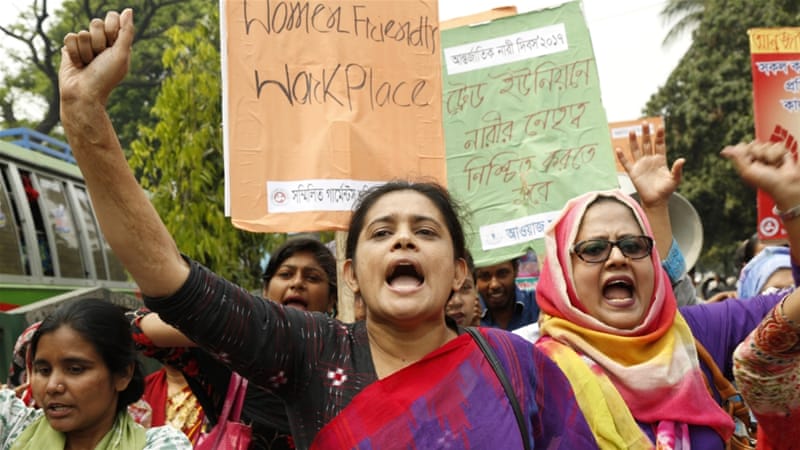Feminism for the 99%: A Manifesto
By Cinzia Arruzza, Nancy Fraser, and Tithi Bhattacharya
Published by Verso, 2019
Reviewed by Laura Fitzgerald
Less than 100 pages long, Feminism for the 99%: A Manifesto will be an attractive read for a new generation politicised by their experiences of oppression and exploitation under capitalism today, and of engaging in struggle. The text ridicules what it dubs “equal opportunity domination” – feminism that is propounded by women in the political and business establishment that remains firmly within the confines of the capitalist system. The text also places emphasis on the women’s struggles emerging around the globe, most particularly the idea of the “huelga feminista” or “feminist strike” as it’s so inspiringly emerged in the Spanish state, Italy, Poland and Latin America.
Feminism for the 99% is a clarion call against liberal or bourgeois feminism, the ‘lean in’ mantra of billionaire Facebook Executive, Sheryl Sandberg. The authors lacerate the shallow mendacity of establishment Identity Politics: “Dedicated to enabling a smattering of privileged women to climb the corporate ladder and the ranks of the military, it propounds a market-centered view of equality that dovetails perfectly with the prevailing corporate enthusiasm for ‘diversity’… Its real aim is not equality but meritocracy.” They also advocate for a splitting of the feminist movement along class lines in order to break with the pro-capitalist feminism that ultimately means the perpetuating of oppression and exploitation: “…we aim to separate the mass of working-class women, immigrants and people of color from the lean-in feminists.”
A central thesis of the authors is that sites of reproduction of a new workforce for capitalism – homes, schools, hospitals etc. – where women tend to predominate doing paid and unpaid labour – will be a vital site of struggle in the years ahead. It’s absolutely true that because of capitalism’s decades-long neoliberal and austerity offensive, which has included an all-out assault on the public sector – including a profit-driven commodification of aspects of the latter – we are seeing inspiring workers’ struggle led by women workers in many of these sectors, from the mass teachers’ strikes in the US, to the nurses and midwives strikes in Ireland.
The authors’ focus on the aforementioned “feminist strike” (which now includes an incredible estimated six million strong general strike across the Spanish state on 8 March 2019) is completely justified. The fact that this phenomenon has emerged is testament to the fact that the most combative, radical sections of the emerging global feminist wave – especially amongst the working class and youth – are instinctively looking towards the traditional methods of working-class struggle in their fightback, particularly its most potent and powerful weapon: the strike.
The authors make the point that this movement has been “democratizing strikes and expanding their scope” and that “Far from focusing only on wages and hours, they are also targeting sexual harassment and assault , barriers to reproductive justice and curbs on the right to strike.” When a highly bureaucratised trade union apparatus has been suppressing workers’ interests , agency and struggle, the emergence of any challenge to that is a necessary lifeblood in the working-class struggle. As a living example of this, in the Spanish state, there was huge pressure exerted from below on the official trade union movement to row in behind the 8 March International Women’s Day general strike.
Similarly, the emergence of the cross-border school student strike for action on climate change will give confidence to workers to push their own unions to take effective action, including strike action. It is a weakness that the authors do not comment on the need to rebuild and revitalize the trade union movement, or on the failure of some trade union leaders to effectively fight on either economic questions or broader issues of oppression and inequality. But the positive reference point of the use of the workers’ movement weapon of the strike is an important point, as well as the inspirational strike action of a political character that has taken place.
At one point the authors briefly reference male workers taking solidarity strike action as part of this. It is a pity that this was not more clearly advocated for. In fact, the idea that only women should strike has been a common theme of debate within such movements, with many liberal feminists only wanting a symbolic strike to illustrate women’s role in society, rather than a more concerted confronting of the political and business establishment. In the Spanish state, male workers striking in solidarity as part of the International Women’s Day general strike meant much more of the economy was shut down, massively increasing the impact of the movement.
The above is connected with another weakness, or imbalance, in the Manifesto. The authors make an important point that the system of capitalism inherently undervalues the work that women disproportionately do – particularly care work, both paid and unpaid. As a means to strike back against this, the authors emphasise the idea of “women’s power: the power of those whose paid and unpaid work sustains the world” and the idea of “withdrawing housework, sex and smiles”. While of course working-class women who are not in paid employment should come onto the streets and organise in their community – and in fact this has always been a vibrant feature of working-class struggle and revolutionary history – the act of striking from unpaid “reproductive” work, not only is impossible for most working-class women (e.g. picking the children up from school, feeding the baby, ensuring elderly relatives can get out of bed), but simply does not provide anywhere near the same potential power as striking from waged work.
This power is broadly derived from the fact that workers are key to creating profit for capitalism. Furthermore, there is something especially powerful and strategic about the solidarity and organisation that can be built at workplace level. The impact and disruption to the system of striking together in solidarity with workmates, including from waged “reproductive” work (reproducing the labour force for capitalism) – like the recent nurses and midwives strike did with 40,000 workers together in huge workplaces – is crucial.
Rather than telling us to “lean in”, it’s welcome that this pithy read inspires us to lean out in struggle and solidarity against the capitalist system of exploitation, oppression and environmental destruction. Although it falls short of explicitly agitating for and explaining the socialist alternative to the latter, Feminism for the 99% will inspire many of its readers to explore socialist feminism.n












